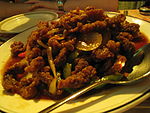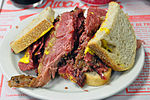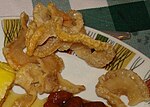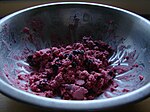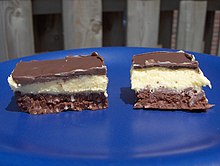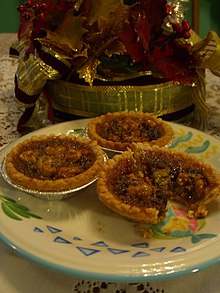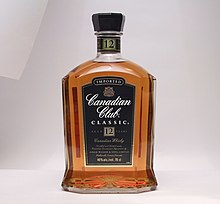https://www.sobeys.com/en/articles/10-quintessentially-canadian-foods/
For most Canadians, what qualifies as our “national” cuisine is a little mysterious. But our provinces and territories do share a love of some distinctive foods that originated from inside our borders. Here are 10 that make us proud to be Canadian.
1. Bannock
A satisfying quick bread steeped in Canadian history, basic bannock is flour, water and butter (or lard) that is shaped into a disc and baked, fried or cooked over a fire until golden. It may have come with Scottish fur traders in the 18th century, or a First Nations version made of corn, nuts and starchy roots could have influenced European settlers, who changed the recipe to include wheat flour. Either way, this easy-to-make bread sustained families and travellers alike through the harsh winter months and is still enjoyed across our great land today.
Try it: Pull-Apart Bannock Bread
2. Nanaimo Bars
There are as many origin stories for these three-layer bars as there are recipe variations. One thing is for sure, though: Nanaimo bars are named after the city in British Columbia. The creamy, custardy centre is what sets Nanaimo bars apart from the buttercream-filled New York slice—both have a smooth chocolate topping and a rich graham cracker crust. You can personalize any of the layers or turn the bars into a completely different dessert, but their B.C. heritage still shines through.
Try it: Combine the flavours of a Nanaimo bar and a Coffee Crisp ® chocolate bar, and you have our super delicious Nanaimo Coffee Crisp ® Cake.
3. Maple Syrup
Canada produces 80 percent of the world’s maple syrup, so we reign supreme when it comes to this sweet treat. We love it so much that we even made the sugar maple our national tree! Luckily for us, it is a versatile ingredient—you can add a touch of maple goodness to just about any dish you can imagine, from salads to cakes to roasts. Learn how Canada’s liquid gold goes from tree to table in our article.
Try it: Roasted Maple Salmon & Brussels Sprouts
4. Saskatoon Berries
The city of Saskatoon was named after these abundant summer berries—not the other way around! Saskatoons were a main ingredient in pemmican, a dried-meat dish that historically nourished First Nations peoples, voyageurs and explorers through the freezing winter months. Sweet and juicy with an almond-like flavour, they are related to apples and continue to ripen once picked. Swap fresh or frozen saskatoons for blueberries in any recipe.
Try it: Replace blueberries with saskatoon berries in our Blueberry Grunt.
5. Caesars
A proud Calgary invention, the Caesar was the brainchild of Italian-born bartender Walter Chell. Legend has it that in 1969, Chell adapted his beloved pasta with clam sauce into this zesty tomato-clam juice cocktail spiked with vodka. The Caesar immediately became hot, hot, hot nationwide—and now it’s often called Canada’s national cocktail. Today’s Caesars are sometimes crowned with over-the-top garnishes, such as spring rolls or lobster tails.
Try it: Ultimate Canadian Caesar
6. Ketchup Chips
Since the 1970s, Canadians have eaten tons of these crunchy chips. While both Canadian and American companies have laid claim to the original recipe, this addictive, finger-staining snack has been wholeheartedly embraced in the Great White North. These days it’s tough to find a chip with the same zippy flavour outside our borders. Crumbled ketchup chips are amazing sprinkled over baked squash, fried eggs and popcorn.
Try it: Ketchup Chip Popcorn
7. Montreal Smoked Meat
This salty, smoky deli beef is a Canadian sandwich superstar, best slathered with mustard and sandwiched in rye bread. Montreal smoked meat is dry-rubbed with more garlic and savoury spices than its sweeter deli cousin, pastrami, before being smoked, steamed and sliced. Think beyond the sandwich and bring Montreal smoked meat’s intense flavours to salads, tacos and appetizers.
Try it: Montreal Smoked Meat Crostini
8. Lobster
Sweet, succulent lobster from our Atlantic waters is loved across the globe. Once a cheap food source for servants and prisoners, Canadian lobster is now the ultimate delicacy. But don’t let its fancy status intimidate you—lobster is meant to be enjoyed! Whether it’s served whole in a Maritime boil or chunked in a long bun with a big dollop of mayonnaise, there’s a lobster dish for every Canadian taste (and budget).
Try it: Chive-Lime Lobster Rolls
9. Donairs
It doesn’t matter if you’re enjoying it as a late-night nosh or a Tuesday-night dinner—a good Canadian donair is all about gobs of sauce. A Nova Scotian twist on traditional gyros, donairs feature spiced ground beef, onions, tomatoes and a tangy-sweet condensed milk sauce. Some say a true donair is served on a soft, Lebanese-style pita for soaking up all the juices, but the sturdier Greek variety keeps the mess to a minimum.
Try it: Donair Burgers & Halifax Sauce
10. Poutine
Warm, gooey and indulgent, the famous Canadian snack of fries, cheese curds and gravy is now adored the world over. It debuted in rural Quebec snack bars in the 1950s and found its way onto Canada-wide fast-food menus by the late 1980s. While poutine purists insist on cheese curds made in eastern Quebec, today’s poutine variations are endless, featuring everything from extravagant foie gras toppers to homemade oven-fry bases.
Try it: Chicken & Goat Cheese Sweet Potato Poutine
For most Canadians, what qualifies as our “national” cuisine is a little mysterious. But our provinces and territories do share a love of some distinctive foods that originated from inside our borders. Here are 10 that make us proud to be Canadian.
1. Bannock
A satisfying quick bread steeped in Canadian history, basic bannock is flour, water and butter (or lard) that is shaped into a disc and baked, fried or cooked over a fire until golden. It may have come with Scottish fur traders in the 18th century, or a First Nations version made of corn, nuts and starchy roots could have influenced European settlers, who changed the recipe to include wheat flour. Either way, this easy-to-make bread sustained families and travellers alike through the harsh winter months and is still enjoyed across our great land today.
Try it: Pull-Apart Bannock Bread
2. Nanaimo Bars
There are as many origin stories for these three-layer bars as there are recipe variations. One thing is for sure, though: Nanaimo bars are named after the city in British Columbia. The creamy, custardy centre is what sets Nanaimo bars apart from the buttercream-filled New York slice—both have a smooth chocolate topping and a rich graham cracker crust. You can personalize any of the layers or turn the bars into a completely different dessert, but their B.C. heritage still shines through.
Try it: Combine the flavours of a Nanaimo bar and a Coffee Crisp ® chocolate bar, and you have our super delicious Nanaimo Coffee Crisp ® Cake.
3. Maple Syrup
Canada produces 80 percent of the world’s maple syrup, so we reign supreme when it comes to this sweet treat. We love it so much that we even made the sugar maple our national tree! Luckily for us, it is a versatile ingredient—you can add a touch of maple goodness to just about any dish you can imagine, from salads to cakes to roasts. Learn how Canada’s liquid gold goes from tree to table in our article.
Try it: Roasted Maple Salmon & Brussels Sprouts
4. Saskatoon Berries
The city of Saskatoon was named after these abundant summer berries—not the other way around! Saskatoons were a main ingredient in pemmican, a dried-meat dish that historically nourished First Nations peoples, voyageurs and explorers through the freezing winter months. Sweet and juicy with an almond-like flavour, they are related to apples and continue to ripen once picked. Swap fresh or frozen saskatoons for blueberries in any recipe.
Try it: Replace blueberries with saskatoon berries in our Blueberry Grunt.
5. Caesars
A proud Calgary invention, the Caesar was the brainchild of Italian-born bartender Walter Chell. Legend has it that in 1969, Chell adapted his beloved pasta with clam sauce into this zesty tomato-clam juice cocktail spiked with vodka. The Caesar immediately became hot, hot, hot nationwide—and now it’s often called Canada’s national cocktail. Today’s Caesars are sometimes crowned with over-the-top garnishes, such as spring rolls or lobster tails.
Try it: Ultimate Canadian Caesar
6. Ketchup Chips
Since the 1970s, Canadians have eaten tons of these crunchy chips. While both Canadian and American companies have laid claim to the original recipe, this addictive, finger-staining snack has been wholeheartedly embraced in the Great White North. These days it’s tough to find a chip with the same zippy flavour outside our borders. Crumbled ketchup chips are amazing sprinkled over baked squash, fried eggs and popcorn.
Try it: Ketchup Chip Popcorn
7. Montreal Smoked Meat
This salty, smoky deli beef is a Canadian sandwich superstar, best slathered with mustard and sandwiched in rye bread. Montreal smoked meat is dry-rubbed with more garlic and savoury spices than its sweeter deli cousin, pastrami, before being smoked, steamed and sliced. Think beyond the sandwich and bring Montreal smoked meat’s intense flavours to salads, tacos and appetizers.
Try it: Montreal Smoked Meat Crostini
8. Lobster
Sweet, succulent lobster from our Atlantic waters is loved across the globe. Once a cheap food source for servants and prisoners, Canadian lobster is now the ultimate delicacy. But don’t let its fancy status intimidate you—lobster is meant to be enjoyed! Whether it’s served whole in a Maritime boil or chunked in a long bun with a big dollop of mayonnaise, there’s a lobster dish for every Canadian taste (and budget).
Try it: Chive-Lime Lobster Rolls
9. Donairs
It doesn’t matter if you’re enjoying it as a late-night nosh or a Tuesday-night dinner—a good Canadian donair is all about gobs of sauce. A Nova Scotian twist on traditional gyros, donairs feature spiced ground beef, onions, tomatoes and a tangy-sweet condensed milk sauce. Some say a true donair is served on a soft, Lebanese-style pita for soaking up all the juices, but the sturdier Greek variety keeps the mess to a minimum.
Try it: Donair Burgers & Halifax Sauce
10. Poutine
Warm, gooey and indulgent, the famous Canadian snack of fries, cheese curds and gravy is now adored the world over. It debuted in rural Quebec snack bars in the 1950s and found its way onto Canada-wide fast-food menus by the late 1980s. While poutine purists insist on cheese curds made in eastern Quebec, today’s poutine variations are endless, featuring everything from extravagant foie gras toppers to homemade oven-fry bases.
Try it: Chicken & Goat Cheese Sweet Potato Poutine





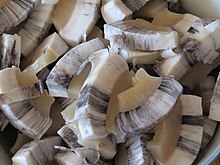
![[icon] [icon]](https://upload.wikimedia.org/wikipedia/commons/thumb/1/1c/Wiki_letter_w_cropped.svg/44px-Wiki_letter_w_cropped.svg.png)

